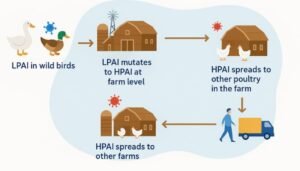Biosecurity Implications and Transmission Routes of Economically Important Poultry Diseases with a Focus on Avian Influenza

Dr. Majed Hamed Al Saegh / poultry pathologist / Australia
1- Introduction
Poultry is one of the most important and affordable sources of animal protein globally. However, the sector faces ongoing threats from infectious diseases. These diseases, especially airborne and zoonotic viruses such as Avian Influenza (AI), cause significant economic losses and pose serious risks to public health. The article by Kovács et al. (2025) presents an in-depth analysis of disease transmission pathways and the urgent need for strict biosecurity measures, with a focus on understanding and controlling AI spread.
2- Overview of Disease Transmission in Poultry, Pathogens in poultry are transmitted through several routes:
- Airborne Transmission: AI and Newcastle Disease (ND) spread via respiratory droplets and contaminated dust. High bird density, poor ventilation, and dry, dusty environments enhance this risk. AI can remain viable for more than eight weeks at 4°C and up to 21 days in water at 20°C.
- Fomite Transmission: Viruses such as AI, ND, Infectious Bursal Disease (IBD), and Salmonella can survive for extended periods on surfaces, equipment, and litter. AI remains effective for 5 days at 24°C and 8 weeks at 4°C.
- Waterborne Transmission: Contaminated or shared water lines act as reservoirs, especially when biofilms form. AI remains infectious for up to 21 days in water.
- Vector-Borne Transmission: Insects (e.g., darkling beetles), mites (e.g., Dermanyssus gallinae), rodents, and wild birds play a major role. Mites can carry AI and Salmonella for months.
- Vertical Transmission: Pathogens like Mycoplasma gallisepticum and Salmonella enteritidis can transmit from breeders to chicks via eggs. AI vertical transmission is rare, and infected embryos usually fail to hatch.
3- Focus on Avian Influenza: Avian Influenza poses a complex challenge due to its diverse transmission routes and environmental resilience. It can spread long distances via aerosols and is often introduced by wild birds. Within poultry facilities, it persists in dust, feathers, water lines, equipment, and litter. Controlling AI requires an integrated strategy addressing all transmission routes. The article provides robust data on AI persistence, highlighting the need for multi-level biosecurity protocols.
4- Biosecurity Strategies , The authors propose a three-tier framework:
- External Biosecurity: Prevent pathogen entry by limiting access, installing disinfection stations, and excluding wild birds. Includes Danish entry systems, traffic control, and certified disease-free supplies.
- Internal Biosecurity: Zone separation, sanitation between cycles, age-group isolation, and all-in-all-out flock policies.
- Operational Biosecurity: Staff training, enforcement of PPE use, health monitoring, and record-keeping.
Pest and vector control through structural modifications and environmental management is also emphasised.
5- Disinfectants and Practical Applications, Effective disinfection is essential to break transmission:
- For AI and ND: Virkon, Accel, Cresol (3%), Phenol (5%).
- Virus inactivation is enhanced with Calcium Chloride mixtures.
- Surfaces must be cleared of organic material before disinfection.
- Water lines should be sanitised to prevent biofilm persistence.
6- Technology and Social Media Use
The article stresses the importance of digital tools, biosensors, and artificial intelligence in disease monitoring. Social media is also recommended for science-based awareness and combating misinformation.

7- Conclusion
Kovács et al. (2025) present a comprehensive review highlighting the multiple transmission pathways of poultry diseases and the critical need for science-based, layered biosecurity strategies. AI, in particular, demands continuous surveillance, rapid response, and strict on-farm practices.
Integrating hygiene protocols, pest control, staff training, and effective disinfection, alongside modern surveillance tools, can significantly reduce the risk of AI and other economically important diseases.



